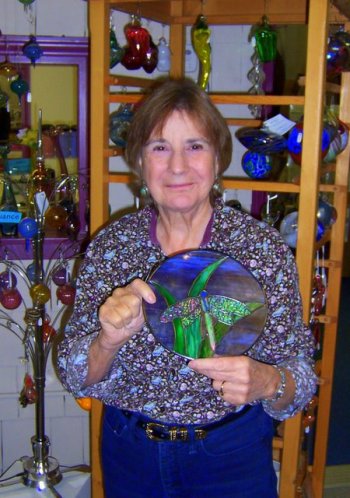Dragonflies are popular themes on ceramics, dishware, jewelry and stained glass. Since they are the insect of choice to be featured in home decor and glass ornaments, I stopped at the Detailed Stained Glass Store on Main Street in Concord to talk with the proprietor, Annette Burgess. She teaches classes on how to create various stained glass designs. She showed me a circular pane of glass on which the image of a dragonfly is artistically embedded. It looked like the fossil of a dragonfly in stained glass.
We learn from the actual fossils of dragonflies that these lords of the sky, some with a 30-inch wingspan, once flew over prehistoric fern forests. The ancestors of present-day dragonflies witnessed the appearance and disappearance of the dinosaurs. With over 5,000 species worldwide, dragonflies are among the most beautiful and interesting insects on earth. In Japanese culture, the motif of a dragonfly is a symbol of victory. Washington, Alaska and Michigan have selected the dragonfly as their official state insect.
Even though they are called “dragons” and have other names like “horse stingers” and “devil's darning needles,” they do not sting or bite. With a voracious appetite for insects, they help control the population of mosquitoes, their favorite food. Their long legs form a basket which they use to catch their prey.
With amazing maneuvers in flight, they can pursue, capture and eat insects on the wing. They can take off backward, launch themselves vertically, hover in air, make all kinds of incredible twists and turns and dart away in a breathtaking zigzag course. They have large compound eyes with thousands of facets that enable them to see in all directions. Their two pairs of transparent wings can move independently of each other and are strengthened by a network of veins. The wing membranes of some dragonflies have a distinguishing pattern of colors and their bodies can have a metallic luster.
Adult dragonflies will lay their eggs in water, and the eggs will hatch into larvae called nymphs which will remain in the water from six months to several years, breathing by gills. The nymphs will molt several times as they increase in size and will feed on the larvae of mosquitoes and other insects. When the time is right, this unattractive (ugly duckling) nymph will crawl up the stem of an aquatic plant where its larval skin will split open and out will emerge (like a beautiful swan) a spectacular jeweled acrobatic creature destined to glide and soar through the air which it now breathes.
Pam Hunt, the senior conservation biologist for the New Hampshire Audubon Society, has just completed a five year survey of New Hampshire dragonflies. With the help of a hundred volunteers, she has identified 164 different species of dragonflies in our state.
Dragonflies are among the most ancient of today's living fauna. What is the secret of their survival? Their unique body design has helped them adapt to the changes on earth during the past 300 million years. They are aerial hunting machines par excellence and have occupied a niche in the environment few other creatures have achieved. No wonder they are symbols of victory, as fossils in rock or as “fossils” in stained glass.






















